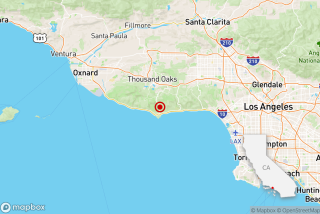Donât Tell Brawley, but Those Smaller Earthquakes Are Good
Last weekendâs earthquake swarm just outside the town of Brawley is yet another demonstration that the Imperial Valley is one of the stateâs most quake-prone areas.
Scores of small quakes regularly hit the region -- swarms that scientists believe are caused by the subterranean injection of magma that heats the Earth and facilitates repeated jolts.
Imperial County is at the northern tip of a volcanically active area extending down the Gulf of California.
The latest swarm started last Friday morning with a quake that could hardly be felt, a magnitude 1.9.
By afternoon, the swarm had picked up. Its 17th quake, at 4:53 p.m., was a noticeable 3.5. Its 50th, at 7:04 p.m., was its strongest, a 4.2. Its 108th was a 3.8 at 11:51 p.m.
Smaller quakes continued into Monday, for a total of 141.
âYou never get used to them,â said Janet Smith, the Brawley city clerk, who has lived in the town for 45 years.
âThey put you on edge, but you have to learn to live with them, like the heat here.â
Last weekâs swarm in Brawley wasnât as bad as the one at the nearby town of Westmoreland in 1981. That lasted several days and produced 1,000 quakes, the strongest of which was a damaging 5.7.
North of Brawley, on the coast of the Salton Sea, is Obsidian Butte, where there is now a geothermal facility for the generation of electricity.
That point marks a long-ago surface eruption of the volcanic system that is linked to the frequent seismic activity.
âThe Imperial Valley is at the northern end of the mid-ocean ridge that is creating, through eruptions of lava, new crust that is becoming a sea bottom,â said Lucy Jones, the scientist in charge of the U.S. Geological Survey office in Pasadena.
In other words, it is a tectonic plate boundary along which, very gradually over many thousands of years, the Gulf of California is spreading out.
The movement is slowly separating the Baja California peninsula from the Mexican mainland.
Scientists have realized in recent years that a fundamental part of the tectonic process is a recycling of the Earth, with new crust welling up from the mantle along so-called ocean ridges, gradually widening the seas and pushing the continents apart.
The good thing about quake swarms, scientists say, is that they allow pressure to be released through many small quakes that occur frequently, thus averting some of the large quakes that can cause widespread destruction and loss of life.
But, as it happens, the Imperial Valley is also the locale of major strike-slip -- or horizontal -- faults, such as the San Andreas, the San Jacinto and the Imperial, which have ruptured sharply over the centuries.
The worst of these quakes in recent times occurred in 1892, 1915, 1934, 1940, 1979 and 1987, and two of them were as big as magnitude 7.1, several times more powerful than any quake recorded in historic times in the Los Angeles Basin.
Two quake episodes on the Imperial fault, which connects the San Jacinto and San Andreas fault zones to the Gulf of California rift zone, caused loss of life.
The second of two strong jolts on June 22, 1915, killed six people in Mexicali, just over the border. A 7.1 quake May 19, 1940, killed seven people in Imperial County.
A picture associated with that 1940 event shows a man at the point where the center line of a highway has been offset by about two feet.
Recent studies by scientists from the Scripps Institution of Oceanography have shown that the Imperial fault is also âcreeping,â or moving without noticeable earthquakes, about a third of an inch a year. That also helps relieve pressure on the fault.
Despite the quakes of the last century along the Imperial, Superstition Hills and San Jacinto faults in the Imperial Valley, there has been none along the San Andreas in the segment ending at Bombay Beach, on the southeast side of the Salton Sea, in about 325 years.
Some scientists think a big quake could occur there in the relatively near future.
They have watched carefully as nearby large quakes, such as the 1992 Landers and the 1999 Hector Mine, both in the 7 magnitude range, have triggered a few small quakes near Bombay Beach.
More to Read
Sign up for Essential California
The most important California stories and recommendations in your inbox every morning.
You may occasionally receive promotional content from the Los Angeles Times.










